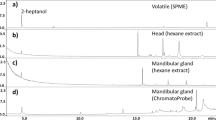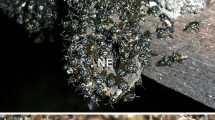Summary
When honeybees sting an object they release pheromones that direct the attack of other bees towards it. 2-heptanone is the principal aggression-provoking component in the secretion of the mandibular gland. Isoamyl acetate is not the only active component of the aggression-provoking secretion at the base of the sting but no such component occurs in the venom itself.
Zusammenfassung
Wenn Honigbienen stechen, lassen sie Pheromone frei, die andere Bienen zum Angriff gegen das Objekt veranlassen. Das 3-Heptanon ist das vornehmste zum Angriff reizende Sekret der Mandibeldrüse. Das Isoamylazetat ist nicht der einzige wirksame Bestandteil des zum Angriff reizenden Sekrets an der Stachelbasis, aber im Gift selbst ist kein ähnlich wirkender Bestandteil vorhanden.
Similar content being viewed by others
References
Boch, R., D. A. Shearer, and B. C. Stone: Identification of isoamyl acetate as an active component in the sting pheromone of the honey bee. Nature (Lond.) 195, 1018–1020 (1962).
Butenandt, A., B. Linzen u. M. Lindauer: Über einen Duftstoff aus der Mandibulardrüse der Blattschneiderameise Atta sexdens rubropilosa Forel. Arch. Anat. micr. Morph. exp. 48, 13–19 (1959).
Butler, C. G.: The honeybee. An introduction to her sense-physiology and behaviour. Oxford: Clarendon Press 1949.
Butler, C. G.: Mandibular gland pheromones of worker honeybees. Nature (Lond.) 212, 5061 (1966).
—: Insect pheromones. Biol. Rev. 42, 42–87 (1967).
Clements, F. E., and F. L. Long: Experimental pollination. An outline of the ecology of flowers and insects. Washington: Carnegie 1922.
Free, J. B.: The stimuli releasing the stinging response of honeybees. Anim. Behav. 9, 193–196 (1961).
Frisch, K. v.: Tanzsprache und Orientierung der Bienen. Berlin-Heidelberg-New York: Springer 1965.
Ghent, R. L., and N. E. Gary: A chemical alarm releaser in honey bee stings (Apis mellifera L.). Psyche (Cambridge, Mass.) 69, 1–6 (1962).
Kerr, W. E., y C. da C. Cruz: Funções diferentes tomadas pela glândula mandibular na evolução das abelhas em geral e em Trigona (Oxytrigona) tataira em especial. Rev. bras. Biol. 21, 1–16 (1961).
Maschwitz, U.: Gefahrenalarmstoffe und Gefahrenalarmierung bei sozialen Hymenopteren. Z. vergl. Physiol. 47, 596–655 (1964).
Moser, J. C., R. C. Brownlee, and R. Silverstein: Alarm pheromones of the ant Atta texana. J. Insect Physiol. 14, 529–535 (1968).
Shearer, D. A., and R. Boch: 2-Heptanone in the mandibular gland secretion of the honey-bee. Nature (Lond.) 206, 530 (1965).
Simpson, J.: Repellency of the mandibular gland scent of worker honey bees. Nature (Lond.) 209, 531–532 (1966).
Snodgrass, R. E.: Anatomy of the honeybee. New York: McGraw-Hill Book Co. 1956.
Wilson, E. O.: A chemical releaser of alarm and digging behaviour in the ant Pogonomyrmex badius (Latreille). Psyche (Cambs.) 65, 41–51 (1958).
Author information
Authors and Affiliations
Rights and permissions
About this article
Cite this article
Free, J.B., Simpson, J. The alerting pheromones of the honeybee. Z. Vergl. Physiol. 61, 361–365 (1968). https://doi.org/10.1007/BF00428008
Received:
Issue Date:
DOI: https://doi.org/10.1007/BF00428008




